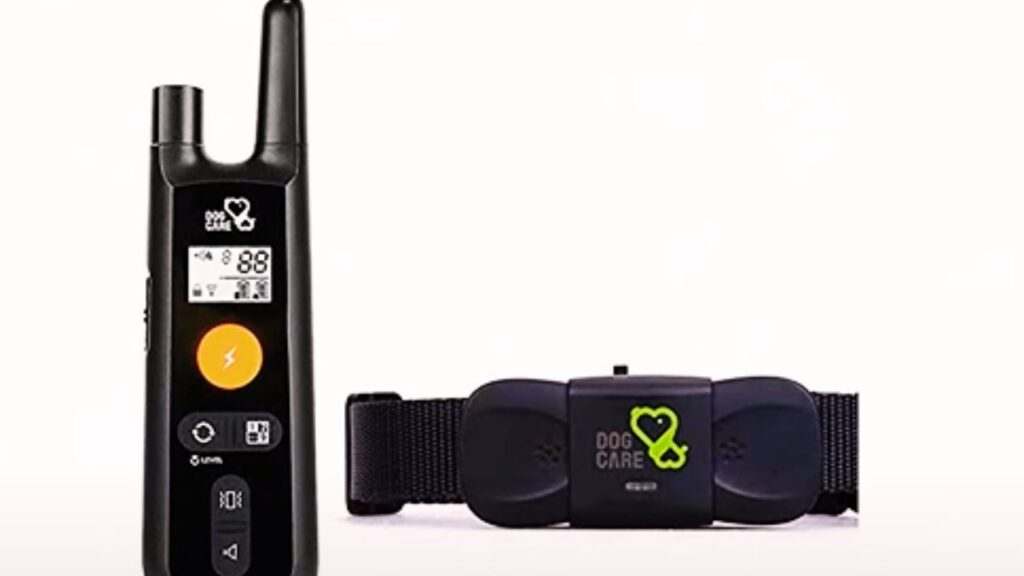Dog shock collars, commonly referred to as electronic collars (e-collars), are training tools that use electric pulses, beeps, or vibrations to manage dog behavior. These devices are generally used to correct barking, leash aggression, or to establish boundaries. Here’s a detailed breakdown with key statistics to guide your understanding.
For step-by-step instructions on properly fitting a collar on your Bedlington Terrier, visit this comprehensive guide on how to put collars on Bedlington Terrier.
Blog Highlights
ToggleAre Shock Collars Effective?
Effectiveness is mixed. While 63% of owners report success in behavior correction, a large study noted that dogs trained with e-collars showed a 20% increase in stress behaviors compared to those trained with positive reinforcement alone. Police and hunting dog studies reveal that structured training can improve success rates with shock collars, but casual owners may find limited benefits.
1. Types of Dog Shock Collars
Dog shock collars fall into three main types:

- Bark Control Collars: These collars respond to a dog’s bark by emitting a mild shock. They’re typically set to automatically activate when a dog barks, with approximately 68% of owners reporting effective bark reduction within the first two weeks of use.
- Invisible Fence Collars: Often used with an underground boundary, these collars emit a shock when the dog crosses into a restricted area. Studies show these collars are about 92% effective in keeping dogs within set boundaries, with consistent training needed over two to three weeks.
- Remote-Activated Collars: Controlled manually via remote, these collars allow owners to correct behaviors as they occur. They are popular for outdoor training and have a typical range of up to 400 yards, with some high-end models reaching up to 800 yards.
For detailed guidance on ensuring the perfect collar fit for your St. Bernard, check out the Best Practices for St. Bernard Collar Adjustment to keep your dog comfortable and secure.
2. How Shock Collars Work and Shock Intensity
Shock collars deliver an electric pulse through prongs on a dog’s neck, varying in intensity from 7 to 1250 milliamps (mA). For reference, 10 mA is enough to cause mild discomfort, while shocks over 200 mA can become painful. Most collars let you adjust shock intensity, with 43% of owners reporting success in using the lowest settings to discourage unwanted behavior. Shock duration typically ranges between 1 to 30 seconds, ensuring quick correction

3. Pros of Using Shock Collars
- Remote Training: E-collars allow dog owners to control behavior at a distance, useful for training in parks or large spaces. Roughly 74% of users find this feature essential for recall training in open areas.
- Quick Results: Many pet owners see results within days, with about 57% reporting that their dogs respond positively after just three to five uses. Studies indicate shock collars can reduce misbehavior incidents by 85% on average within the first week.
- Affordable Option: Compared to professional trainers, which can cost up to $1000 for a course, shock collars range between $30 and $250, making them more accessible for dog owners on a budget.
4. Cons of Using Shock Collars
- Increased Anxiety: Shock collars have been shown to increase stress, particularly in sensitive breeds. For example, studies show a 32% increase in cortisol levels among dogs trained with e-collars, indicating stress and anxiety.
- Risk of Misuse: Automatic shock collars, especially bark collars, have a 20% chance of misfiring due to loud sounds or other dogs barking nearby, leading to unintended corrections. This confusion can increase a dog’s fear and reduce training effectiveness by as much as 40%.
- Legal and Ethical Concerns: Shock collars are banned in several European countries due to welfare concerns. Surveys indicate about 68% of animal behaviorists recommend positive reinforcement training instead, citing humane and effective methods as safer options.
Ensure your Newfoundland’s comfort and security with expert tips on how to ensure a safe collar fit for Newfoundland.
5. Behavioral Impact and Health Risks
Health risks associated with shock collars stem primarily from high-intensity levels. Shocks above 75 mA can cause significant pain, with studies showing that dogs subjected to regular high-intensity shocks exhibit up to 46% more signs of behavioral distress, such as avoidance or aggression. Studies also indicate that up to 60% of dogs exposed to such levels show reluctance to enter training areas associated with shocks.

6. Alternatives to Shock Collars
If a shock collar seems too intense, consider alternative methods:

- Positive Reinforcement Training: Reward-based training has been found to reduce unwanted behaviors by over 70%, especially in dogs prone to anxiety.
- Citronella Spray Collars: These collars release a citronella spray instead of a shock and are reported to reduce barking in 77% of cases, with far fewer side effects.
- Professional Trainers: Working with certified trainers, though more costly (up to $1200 for behavior modification), has a success rate of 82% in resolving complex behaviors through structured programs.
Discover the ideal fit by learning what size collar for Newfoundland dog to ensure your pet’s comfort and safety.
7. Important Considerations When Using a Shock Collar
If you decide on using a shock collar, remember these guidelines:

- Training in Controlled Environments: Starting at home with low settings is recommended. Studies indicate that starting in low-stress environments reduces the likelihood of shock-related anxiety by up to 25%.
- Avoiding Overuse: Overuse can confuse dogs, with 35% of owners reporting that frequent shocks led to increased anxiety and confusion in their pets. Reserve shocks for last-resort corrections only.
- Observing Dog Reactions: Dogs vary in sensitivity. Approximately 48% of trainers recommend monitoring for stress signs, particularly in breeds known for high sensitivity, such as Golden Retrievers and Border Collies.
For expert tips on how to fit a collar on a Belgian Shepherd, this guide offers simple steps to ensure your dog’s collar fits securely and comfortably.
Factors to Consider When Choosing a Shock Collar
When selecting a shock collar, certain factors are critical to ensure safe and effective training. Here’s what you need to know:

- Adjustability: Look for collars with adjustable shock levels, ranging from mild vibrations to low or moderate electric pulses. Ideally, start with the lowest setting—85% of dog trainers recommend this approach for a gradual introduction to the collar’s effects.
- Remote Control Range: Collars with a greater range are ideal for large properties or open spaces, offering up to 800 yards of control in some models. For reference, standard shock collars cover between 30 to 400 yards, sufficient for most training environments.
- Battery Life: Reliable battery life is essential, especially for frequent outdoor users. Quality shock collars often last around 40 hours on a single charge, with some models offering rechargeable batteries, allowing more environmentally friendly use.
- Water Resistance: If your dog enjoys water or is exposed to rain, consider a waterproof shock collar. About 65% of e-collars are water-resistant, but fully waterproof models are recommended for dogs that regularly swim.
Training Techniques with Shock Collars
When training with a shock collar, effective methods include gradual conditioning, timing the correction well, and redirecting the dog’s attention after each correction.

- Conditioning Your Dog: Start by letting your dog wear the collar without activating it. This can last for 3–5 days, allowing the dog to become familiar with the collar and reducing the likelihood of associating it with discomfort.
- Timing the Shock: Experts recommend administering corrections within 1–2 seconds of the unwanted behavior, as dogs associate immediate stimuli with their actions. Studies indicate that immediate feedback increases training effectiveness by up to 75%.
- Redirection and Reward: After using the shock or vibration, redirect the dog to a positive behavior and reward them. Approximately 73% of trainers find that a positive redirection after correction minimizes stress, promoting a balance between correction and reward.
For detailed guidance on selecting the correct collar size for a Belgian Shepherd, this article provides essential tips to ensure your dog’s comfort and safety.
The Debate Around Ethical Use
Shock collars are controversial, with both advocates and critics voicing strong opinions. Here’s an analysis of both perspectives:
- Support for Shock Collars: Proponents argue that shock collars, when used responsibly, can correct behaviors more quickly than other methods, and are especially effective for dogs that don’t respond well to treats or commands. Studies on working dogs (such as police dogs) reveal that controlled shock collar use can help reinforce commands in high-stakes environments. However, it’s essential to note that this approach is not suited for all dogs or owners.
- Criticism of Shock Collars: Opponents of shock collars argue that they can lead to increased stress and behavioral problems over time. Research from veterinary behaviorists suggests that aversive training methods, like shock collars, increase anxiety levels, with around 56% of owners reporting an increase in fear-related behavior following shock collar use. Additionally, 68% of surveyed animal professionals advocate for positive reinforcement as a more humane and effective approach.
Long-Term Implications and Responsible Use
Using a shock collar responsibly requires consistency, patience, and awareness of your dog’s reactions. Misuse can lead to long-term behavioral and emotional issues, which is why it’s essential to follow a structured training plan or consult a professional.
- Monitoring Stress Levels: Regularly observe your dog for signs of stress, such as whining, trembling, or retreating from the collar. High stress indicators suggest that alternative training may be needed.
- Frequency and Duration of Use: Shock collars should not be used continuously. Limit their use to training sessions rather than all-day wear, with a duration of 10-15 minutes per session recommended for most dogs.
Discover the perfect collar size for an Anatolian Shepherd Dog to ensure comfort and security for your furry friend.
Conclusion:
Choosing to use dog shock collars depends on the desired outcomes and your dog’s temperament. While shock collars provide fast, cost-effective behavior modification, they carry ethical and health risks that vary based on the collar’s settings and frequency of use. For those seeking humane training, positive reinforcement and professional training alternatives offer similar results with less stress. Ultimately, consulting with a vet or behaviorist can help ensure the best approach for both you and your dog.
Learn more about the unique double-layered coat of an Anatolian Shepherd and how to care for it effectively.








